Spring cleaning for your yard can start to take place many months before the cold weather breaks. Lawn care for spring can start in the fall or at least a few weeks before the first frost. The benefits of preparing your lawn for the spring season are plentiful.
Spring Lawn Care Checklist

- De-thatching
- Lawn aeration
- Fertilization
- Over-seeding
- Weeding
- Watering
- Mowing
With necessary clean-up, lawn care for spring, and a few special techniques, you can achieve a spring-ready lawn. Apply these techniques and products before your grass enters dormancy, and when the weather warms up, your grass will grow healthier and stronger than before. With techniques like over-seeding and fertilization, you will be well on your way to perfecting your lawn care for spring. Let’s dive into these lawn care techniques, starting with de-thatching.
Dethatching your Lawn
Thatch results from residual layers of dead grass and other debris, accumulating between the soil and grass blades. This thick mat can prevent grass from receiving enough water and air by restricting diffusion and water flow into the soil. To help rid lawns of this unwanted dead grass, we advise removing this layer through dethatching at least once a year.

If your grass is looking a little puffy, it’s likely time to dethatch your lawn. Depending on the level of thatch accumulation in your lawn, you may want to use a leaf rake, a hand tool, a dethatching rake, or even a power rake. These tools help to loosen and remove the thatch, however thick or thin the thatch may be. The best way to get rid of thatch is to move your tool of choice in the same direction, raking along the grass.
Dethatching is one way to improve your yard when overhauling your lawn care for the spring routine, but the best time to dethatch your lawn will vary depending on your grass type. Cool-season grasses can be dethatched in the fall, while the early spring is perfect for warm-season grasses. No matter what time of year your lawn undergoes dethatching, it will reap the benefits of a great growing season afterward.
Lawn Aeration
Aerating your lawn involves increasing the soil's
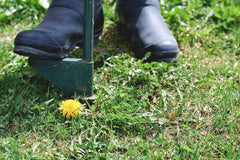 exposure to water, air, and nutrients. Lawn aeration creates small holes that tunnel into the soil for the elements and necessary nutrients to travel faster to the soil and plant roots. Though lawn aeration is unnecessary every week, it is a critical grass care step when planning lawn care for spring. Learn more about the right time to aerate your grass and why it's so essential for healthy soil here.
exposure to water, air, and nutrients. Lawn aeration creates small holes that tunnel into the soil for the elements and necessary nutrients to travel faster to the soil and plant roots. Though lawn aeration is unnecessary every week, it is a critical grass care step when planning lawn care for spring. Learn more about the right time to aerate your grass and why it's so essential for healthy soil here.
The process of lawn aeration creates a surface that is optimal for fertilization. When you reduce soil compaction and improve soil moisture, your lawn will be more receptive to fertilizer.
Fertilize Lawns and Restore Nutrient-Balance
Creating a nutrient-rich and balanced foundation for plants to thrive is necessary for any season but is especially important when your grass is entering a season of dormancy. Lawn fertilizer can help feed your lawn through the more relaxed winter months. Fertilize lawns with our lawn food, which provides a balanced amount of macronutrients (nitrogen, phosphorus, and potassium). These essential nutrients are critical for grass health and growth.
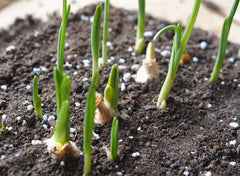 Liquid products are easy-to-use, provide fast results, and are distributed uniformly with a liquid sprayer. To use liquid lawn food, attach the sprayer to your watering hose. Using a back and forth motion, aim to make the fertilizer application as even as possible. To fertilize lawns in a liquid state is more impactful than granular fertilization because it is water-soluble and quickly absorbed by the soil.
Liquid products are easy-to-use, provide fast results, and are distributed uniformly with a liquid sprayer. To use liquid lawn food, attach the sprayer to your watering hose. Using a back and forth motion, aim to make the fertilizer application as even as possible. To fertilize lawns in a liquid state is more impactful than granular fertilization because it is water-soluble and quickly absorbed by the soil.
If you are unsure if your soil is nutrient deficient, consider conducting a soil test. A test will help you better understand any imbalances or deficiencies in your lawn as you are preparing your lawn care for spring. Check out these nutrient-rich blends to fertilize lawns:
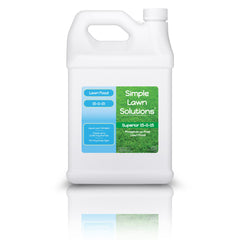
- Lawn Booster: Lawn Energizer Iron and Nitrogen Blend
- Lawn Food: 16-4-8 Complete Balanced NPK
- Lawn Food: 3-18-18 High Phosphorus and Potassium NPK
Our liquid fertilizers are specially formulated to suit your needs, whatever nutrient deficiencies your lawn might be experiencing. With the right fertilizer and proper lawn care methods, you will be on your way to vibrantly green and growing grass. Next, let’s learn the benefits of overseeding your lawn for spring growth.
Overseeding Your Lawn
Giving your lawn a head start for spring growth starts with overseeding. It is the process of planting new grass seed over an existing lawn to grow thicker, denser grass. Your grass can take a beating from pets, kids, heat, or other foot traffic, and sometimes this traffic can result in bare spots on your lawn that overseeding can correct.
By lessening the bare patches' presence, weeds are less likely to
 pop up in your grass. Overseeding boosts your lawn's aesthetic by filling in patchy, thin, or bare spots, but there is also a more profound benefit. It works to reinvigorate your lawn by creating a thicker, more robust texture.
pop up in your grass. Overseeding boosts your lawn's aesthetic by filling in patchy, thin, or bare spots, but there is also a more profound benefit. It works to reinvigorate your lawn by creating a thicker, more robust texture.
Are you wondering how to start overseeding your lawn? Follow these steps to do so during your lawn care for spring:
- Prepare your lawn—by keeping the grass at a short length and removing any dead grass, weeds, or other debris, you can create the ideal area for new seeds to join with the soil.
- Seeding—it can be done by hand or with a lawn spreader for a more uniform application.
- Water—adequate watering is required to activate seed germination, even when overseeding an established lawn.
After overseeding, try to limit mowing the lawn for at least one week, two weeks is better, to prevent damaging new grass seedlings. If you are overseeding in the late fall, dormant seeding is the process that allows the preservation of grass seeds through the cooler months. When the weather begins to warm up in the spring, seed germination will resume.
Overseeding is useful in progressing your lawn care for spring. It reinforces your turf with new grass that will grow and stand against summer heat and foot traffic.
Watering Your Lawn the Right Way
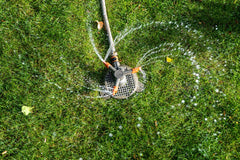
Watering your lawn is an essential task. To make sure your grass comes out strong in the springtime, monitor the amount of moisture your lawn is receiving during dormancy. If you are working with cool-season grass, the season of dormancy may start in late fall and carry through the winter months. Look for signs of dry, crusted soil to see if your lawn could use a boost from a late-season watering session. Maintaining a drought-free lawn will ensure that your grass is not damaged or dead come spring.
Making sure your lawn is receiving enough hydration throughout the year is essential. Without the proper hydration, your grass cannot produce food or grow deeper roots to absorb the proper nutrition to survive.
Follow these rules to ensure your lawn is receiving enough water:
-
Aim to provide one to two inches of water to your grass every week
-
Set up a watering schedule and use programmable sprinklers if possible to make this lawn care task a no-brainer
-
Adjust to accommodate for rainfall
 Watering the lawn is an important step to keeping it nourished, even throughout the cooler seasons. Aim to water your grass for one to two inches each week and slowly taper off the amount of watering time as your grass enters dormancy. You may need to provide additional hydration through the winter months to create a strong, long-lasting turf that will emerge in the spring. Please note, that this tip does not apply to regions that experience freezing temperatures, snow, and ice.
Watering the lawn is an important step to keeping it nourished, even throughout the cooler seasons. Aim to water your grass for one to two inches each week and slowly taper off the amount of watering time as your grass enters dormancy. You may need to provide additional hydration through the winter months to create a strong, long-lasting turf that will emerge in the spring. Please note, that this tip does not apply to regions that experience freezing temperatures, snow, and ice.
Watering is just one way you can keep your grass strong through winter maintenance and excellent lawn care for spring. For more grass care tips, check out everything you need to know about watering your lawn and apply these same techniques to your spring lawn care.
The First Mow of Spring
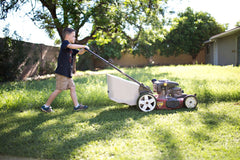 Mowing your lawn is likely the lawn care task that you are most comfortable with. Though some may think that there's no way to go wrong with cutting the grass, there are some steps you can take to improve this part of your lawn care routine, especially when it comes to perfecting your lawn care for spring.
Mowing your lawn is likely the lawn care task that you are most comfortable with. Though some may think that there's no way to go wrong with cutting the grass, there are some steps you can take to improve this part of your lawn care routine, especially when it comes to perfecting your lawn care for spring.
Incorrectly mowing your lawn before it enters dormancy could be detrimental to spring growth. When preparing your lawn for winter, slowly begin to trim grass shorter and shorter. The short mow should be done progressively instead of all at once to avoid shocking the grass. Preparing your lawn for winter with the right length of mowing will ensure the grass will come out strong in the spring.
To set yourself up for excellent lawn care for spring, make sure not to cut the grass too early. Ensure that the lawn has had an excellent chance to grow, aiming for grass blades to reach at least two inches tall. Once your grass has reached this length, the roots are likely warmed. Cutting your grass too early could shock your lawn and even injure it.

After the first mow of spring, you can use the following guidelines for mowing your lawn the right way. The first step in mowing your lawn is to make sure you follow the one-third rule, which involves only trimming the top third of grass blades with each mow. Ensure the blade on your lawnmower is set to the appropriate height, and follow a consistent schedule, monitoring your grass length to maintain this structure.
To promote grass growth, add variety to your mowing pattern. Switching up your mowing pattern discourages the matting down of the grass blades. If you're looking for new patterns to mow your lawn, try mowing diagonally, vertically, and horizontally. These new techniques will improve your lawn care for spring and make your yard the envy of your neighbors.
Make sure that lawn mowing does not occur too frequently. If you're unsure if you are over-cutting or not, check your grass for signs of damage. Bare, patchy spots that mimic the pattern of your mows are a sign that you’re mowing too often. Monitor how your lawn reacts after the first cut from spring and adjusts your lawn care routine for grass mowing from there. Consider these mowing tips when perfecting your lawn care for spring and other seasons.
Weed Removal and Prevention Tips
Pesky weeds are not only an eyesore in your yard; they can quickly overtake your lawn. While spring marks the beginning of grass growth, it is also an opportune

time for grass weeds to infiltrate your lawn. Weed removal is a necessary step in any season, but especially for proper lawn care for spring. Let's learn all about how you can efficiently remove weeds from your grass and prevent future growth.
Weed removal can seem like a daunting and overwhelming task. To prevent yourself from tiring out from this lawn care task, work to remove weeds in phases, capturing one area of your lawn at a time. When removing weeds, be sure to pull up directly on the weed, capturing the plant at the root. Weeds can quickly spread seeds, so be sure to take precautions when removing weeds. Keep a plastic bag nearby during weed removal to carefully and delicately discard the plants.
To prevent future weed growth, actively check your grass for new weeds during your lawn care for spring and into the summer as well. As soon as you spot a weed, it is critical to remove it right away before it spreads. If you want some help during this part of your lawn care, you can opt to use a safe herbicide to treat lawn weeds or purchase some helpful weed removal tools. Follow these weed removal steps before overseeding so that the new seeds can have a proper, cleared space to live in the soil.
Whether you’re looking to fertilize lawns in the winter or perfect your lawn care for spring, Simple Lawn Solutions will teach you the right techniques for all of your grass care needs.










2 comments
Hello Jay,
Thank you for your comment. Please send us an email or fill out our questionnaire so we can make some custom recommendations for you!
https://simplelawnsolutions.com/pages/lawn-questionnaire
I’ve been trying to fix a few bare spots in my lawn for about 1 year now, still nothing and I’ve tried many things. Can you please help me! I live in Michigan and overall my yard is well maintained except these few spots!! Great content too!